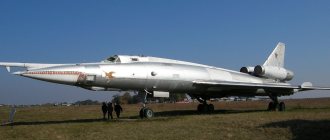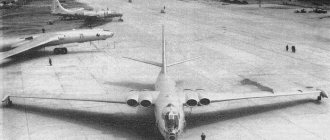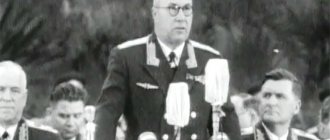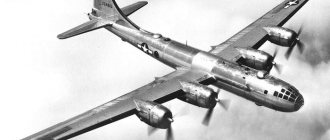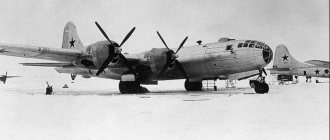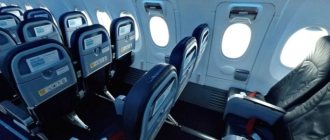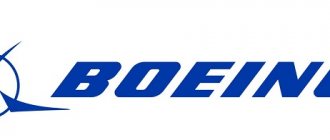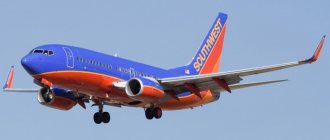Apparently, patrolling near the Russian borders is a nerve-wracking task. So the pilots of the American multi-role reconnaissance aircraft P-8 Poseidon (“Poseidon”) told CNN that every time they meet Russian supersonic Su-27 fighters in the skies over the Black Sea, they feel fear. Captain Tim Thompson called the main danger a possible miscalculation of the human factor by the Russian crews of interceptor aircraft, and Lieutenant Daniel Loudon said that the crew “throws out adrenaline at every meeting,” because Russian fighters can instantly change the trajectory and altitude, while the Poseidons are designed for calm flight without sudden actions.
Nevertheless, the Americans continue provocations in the skies near the borders of Russian Crimea. Although there are known cases when they got a lot of punishment for such tricks.
And they hit me on the nose
On the evening of July 1, 1960, an American military aircraft violated the state border of the USSR over the Barents Sea, 22 kilometers north of Cape Svyatoy Nos and was shot down by a Soviet fighter. “They definitely needed this Holy Nose,” Nikita Sergeevich Khrushchev joked at a press conference on July 12. “And it was near this Nose that they poked their nose into us.”
For ten days, while Nikita Khrushchev was on a trip abroad, the Soviet side did not report anything about the destruction of the intruder aircraft. Apparently, they were waiting for his return and the corresponding decisions. However, at the press conference with the participation of the Soviet leader, they talked only about the final stage of this dramatic story.
The navigator and co-pilot, first lieutenants of the US Air Force John McCone and Freeman Olmsted (out of the six crew members of the American plane, they were the only ones who survived) told the details during the investigation in the USSR State Security Committee.
From the investigation materials
“The preparation for the flight was unusual, even strange, but something else struck us. The crew commander, Captain Ernst Palm, was accompanied by his wife.
- What does the wife have to do with it? (investigator's question - Ed.)
— It’s a bad omen when a pilot is accompanied by his wife. She had never seen him off before, but here she was saying goodbye, as if she would never see her husband again, with tears in her eyes. Our commander apparently knew what kind of flight was ahead...
Soviet fighter pilot Captain Vasily Polyakov stopped the flight of an American RB-47 aircraft exactly two months after a U-2 piloted by US Air Force First Lieutenant Francis Powers was shot down over the Urals. And the world community was interested in what it was: either the Americans aggravated the international situation and therefore staged an adventure, or did the RB-47 simply get lost? The actions of the crew, supported by the testimony of the pilots themselves, allowed the Soviet side to conclude that this was a pre-planned espionage action with the task of reconnaissance of a strategically important area of the USSR and checking whether the bomber, converted into a long-range reconnaissance aircraft and designated RB-47, would be detected.
© fishki.net
Soviet fighter pilot Captain Vasily Polyakov stopped the flight of an American RB-47 aircraft.
The plane, which belonged to the aviation unit of the American military-strategic intelligence, took off from the American military base in Brize Norton (England) on July 1, 1960 at 10 o'clock GMT and headed along a route that ran along the northern borders of Norway and the Soviet Union. Similar flights have been made before, but...
From the testimony of first lieutenants McCone and Olmstead:
“A few days before the departure, we were given a lesson on how to behave in Russia if we were suddenly “carried” there. They advised to secretly contact diplomats at embassies and consulates of Western countries. Immediately before departure, the unit commander, Major Debell, warned us: the flight must be kept in strict confidence - you are prohibited from maintaining regular radio contact with the base. And then he handed the crew commander a package; this had never been done before.”
The peculiarities of the flight were that the navigator had to make corrections: for some reason the plane kept deviating from the planned route. At the inquest, John McCone was asked: “Could the crew commander have done without a navigator?” After thinking, the pilot replied that Captain Palm, being an experienced pilot (by that time, figuratively speaking, he had flown around the whole world), flew the plane on his own. By eighteen o'clock Moscow time, the RB-47 was already flying over the Barents Sea, with the waters of the USSR under its wing.
© flickr.com
Boeing RB-47 Stratojet at the US Air Force Museum. Dayton, Ohio.
oPNEYRKHPNBYUMKHE PUGBEDSHBUREKEMNTSN BYUPHYUMRYU ANLAYUPDHPNBYHYU b-47b MYVYUKNYAE B LUPR 1951 Ts. oPEDONKYUTSYUKNYAE, VRN SCHRN ASDER OPNLEFSRNVMSHI BYUPHYUMR, ONYU B YARPNI ME BYARSOHR YAOEZHYUKEMSHI PUGBEDVKHY RB-47E.
dKЪ RB-47B PEHKKH HYAONKEGNBURE YAKHYARELS SOPYUBKEMKH YUPRHKKEPKHIYAYHL NCM╦L yu-5 KHANKEE LNYMSHE DBKHTTSUREKH J47-GE-25. vRN YYUAYUERYA PUGBEDSHBUREKEMNTSN NANPSDNBYUMKH, RN ASHKYU PUGPYUANRYUMYU YAOEZHHYUKEMYU OKURTNPLYU I BNYAELECH TNRNYYULEPYULH. schRYU OKYURTNPLY SYARYUMYUBKHBUKYUYAE B ANLANBSHI NRYAYE, RYUHL NAPUGNL ANLAYUPDHPNBYKHY LNFMN ASHKN ASHIARPN OEPENANPSDNBURE B PUGBEDVKHY. ANLANBSHI NRYAYE RUYFE RPEANBUK DNPUANRYH: NANPSDDNBUKH KCHY LEFDS YYUAKHMNI X ANLANBSHL NRYAYNL, OPNKNFHKH YUAEKKH DK SOPIUBKEMKH TNRNYYULEPYULH X RPSANOPNBND DK ONDYUVH R╦OKNTSN BNGDSUYU DKH NANTSPEBYU. oНМЪРМН, ВРН ДУММУЪ YAKHYARELYU LNTSKYU HYAONKEGNBUREYA RNKEIN DM╦L. xMREPEYAMN, VRN RB-47B YARYUKH ONYARSOYURE B yayuy PYUMEYE, VEL ASHK HYAOSHRYUM SHYAOEPHLEMRYUKEMSHI YRB-47B. ONYAKEDM BEPYAKH YAKSFHKYU DK ANKEE TSKSANYNI NRPYUANRYKH PUGBEDSHBUREKEMNI BEPYAKHH b-47. bYaETsN ASHKN OEPENANPSDNBUMN 90 YYULNK╦RNB B BEPYAHCH RB-47B, YNRNPSH ONYARSOKHKH MU BNNPSPHEMKHE B 91-e yuBKHYUPSHKN YARPURETSKHVEYAYNI PUGBEDYKH B 320-e ANLAYUPKHPNB NVMNE YUBKHYUPSHKN. b NYAMNBMNL ShchRKH YYULNK╦RSH HYAONKEGNBUKKHYAE YUY SVEAMSHE, DK ONDTSNRNBYKH SCHYHOYUFEI YAOEZHHYUKHGHPNBYUMMSHU RB-47E.
schRN ASHKYU YAOEZHYUKEMYU PUGBEDSHBUREKEMYU BEPYAH, YANGDUMMYU MU NYAMNBE b-47e. b NRKHVHE NR OPNRNRKHOYU, MNYANBUYU VYUARE ASHKYU SDKHMEMYU MU 825 LL. shRN ONGBNKHKN B TSEPLERKHVMNI YUAHME I YNMDKHZHNMHPNBYUMMSHL BNGDSUNL PYUGLEYARKHRE NDKHMMYUJURE TNRNYULEP KH DPSTSNE VSBYARBKHREKEMNE NANPSDNBYUMKHE.
b ANLANBNNL NRYAYE BYA╦ ANLAYUPKHPPNBNVMNE NANPSDNBYUMHE ASHKN YAMIRN, YU BLEYARN METSN SYARYUMNBKEMSH OPKHYAONYANAKEMKH DK BSHOSYAYU NYABERKHREKEMSHU ANLA X YAOEZHHYUKEMSHU OYURPNM NB TNRNBIAOSHYKH. b YYUAHME SYARYUMNBHKH YAOEZHYUKEMSHI BHDNHYAYUREKE H YAHYARELS SOPIUBKEMKH YYULEPYULH. nANPNMHREKEMNE NPSFHE KH OYUPSH 20-LL AXIS I YAHYARELNI SOPYUBKEMKH NTsM╦L yu-5 ASHKN YANUPYUMEMN.
YaYULNK╦R KHLEK YAHYARELS DNGYUOPYUBYKH B BNGDSUE, MN, MEYALNRP MU SHCHRN, ╦LINYARE BMSRPEMMKHU AYUNB ASHKYU DNBEDEMYU DN 69,750 K.
yYuY SHRN MH SDHBHREKEMN, MN MU MEINRNPSHU RB-47E BEPMSKKHYAE Y BYARPNEMMNI YAHYARELE SAYNPHREKEY RATO I 18 “ASRSHKYULH”.
schYHOYUF NYARYUKYA OPEFMHL - 3 VEKNKBEYU, YU I PUGBEDSHBUREKEMSHL NANPSDNBYUMHEL SOYUBKKYA URSPLYUM-TNRNTSPYUT. yYULEPSH KHLEKH YUBRNLYURHVEYAYNE SOPIUBKEMKHE NR TNRNSHKELEMRYU - B LNLEMR BYAOSHYKH NYABERKHREKEMNI ANLASH NRYPSHBUKYA GYURBNP.
RYUYKHL NAPUGNL, BSHOSYAYU ON NVEPEDH ANLASH XKH OYURPNMSH, LNFMN ASHKN ONKSVKHRE TNRNTsPYUTKHH ONKNYASH LEYARMNYARKH ANKENNTSN PUGLEPYU. oEPBSHI RB-47E BGKEREK 3 KhChK 1953 Ts., YU ONYAKEDMKHI - B YUBTSSYARE 1955-TsN. gyu ShchRNR OEPKHND ASHKN BSHOSYEMN 255 PUGBEDVKHYNB RB-47E, HG MHU ONYAKEDMKHE 15 LYUHM ASHKH GUYNMVEMSH B BEPYAKHH PUGBEDVKHYU ONTSNDSH - RB-47K.
schRKH YAYULNK╦RSH ONYARSOKHKH MU BNNPSFEMKHE 7-TSN YUBKHYUPSHKYU YARPURETSKHVEYAYNI PUGBEDYKH (No. 26, 55, 70, 90, 91, 301 X 305).
xMREPEYAMN NRLERHRE, VRN MEINRNNPNE BPEL B DNISLEMRYU bbya YYULNK╦R NANGMYUVYUKYA R-47E, AEG ASYBSH “b”. shRN FE LNFMN YAYUGYURE KH N YAYULNK╦RYUU PUDHNSCHKEIRPNMMNI BNIMSH e-47e (RNFE AEG “b”).
nANGMUVEMHE eb-47e
OPHLEMKNYAE YN LMNTsHL BYUPKHYUMRYUL OEPEDEKNY b-47e, B YAYULNK╦R PUDHNSCHKEIRPNMMNI ANPEASH (psha). oEPBNMYUVYUKEMN SCHRN ASHK YAOEZHYUKEMSHI YNMREIMEP, RYU MYUGSHBUELNI “yaRYUDHH IV”. schRNR YNMREIMEP KHLEK MEYAYNKEIN PUGBEDSHBUREKEMSHU OPH╦LMKHYNB RHOYU AN/ALT-16, OUPS OPEDYURVKHYNB ONLEU AN/ALT-6B X OPEDSOPEFDUCHYKHI NAMYUPSFHREKE pkya NAKSVEMKH AN/APS -54. yPNLE SCHRNTSN, B UBNYARNBNI VYUYARKH TCHGEKKFYU ONYARYUBHKH DBE SYARYUMNBYKH DK BSHAPNYAYU DHONKEMSHU NRPYUFYUREKEY AN/ALE-2.
sVEMHЪ B 1957 Ts. ONYUGYUKH, VRN OPHLEMEMKHE eb-47e LNTsKN NYABNANDHRE SDYUPMSHE b-47e NR ONYARYUMNBYKH KHMDHBKHDSYUKEMSHU PUDHNONLEU. bN BPEL SVEMKHI YUPLYUDYU HG 30-40 SDYUPMSHU b-47e, OND OPKHYPSHRHEL 14 eb-47e, “MYUOYUDYUKH” MU YAEBEPN-BNYARNVMSCH VYUARE yayu YAN YARNPNMSH yYUMYUDSH. th BNYARNVMNLS ONAEPEFECH yuLEPHYH ANLAYUPDHPNBYHYH ONDUNDHKH MU BSHYANRE 7600-9150 LH MYUPYUBKKKHYAE Y YABNHL ZHEKL (anYARNM, MECH-INPY, bYUHMTsRNM X DP. TsNPNDYu M YONAEPEFEE). YaYULNK╦РШ eb-47e PUYAOPEDEKKHKHYAE MU MEYAYNKEIKHU BSHYANRYUU KH MYUVYUKH TSKSEMKHE. sDYUPMSHE YYULNK╦RSH OPEYYURKHKH ONYARYUMNBYS YANAYARBEMMSHU ONLEU, BSHYKCHVHKH PUDHNYARYUMZHKH X RHUN YAOSYARHKHKHYAE MU BSHIANRS 300 L. MU SHCHRNI BSHYANRE NMH OPENDNKEBYUKH YAPED YARBU obn, OPHYPSHBYUBKHE ZHEKH. b PYYINMYU ZHEKEY b-47e BSHONKMKKH ONKSOERKCH I SYAKNBMSHL YAAPNYANL ЪDEPMNI ANLASH H RUYFE MU LYUKNI BSHYANRE SUNDHKKH HG NOYUMNI GNMSH. yNLYUMDNBYUMKHE obn ASHKN BSHMSFDEMN OPHGMURE, VRN ANLAYUPDHPNBYKHYKH BSHONKMKHKH YABNCH GYUDYUVS…
YAKEDSCHIYU LNDKHTHYUZHKH DK PUDHNSCHKEIRPNMMNI ANPEASH MYUGSHBUKYUYAE “YARYUDKH V”. dKЪ ME╦ ASHKYU PYUGPYUANRYUYU YAOEZHYUKEMYU TSEPLERHVMYU YYUOYASKYU, YNRNPYU SYARYUMYUBKHBUKYUYAE B ANLANBNNL NRYAYE. b SCHRNI YYUOYASKE PYUGLEYUKKHYAE DBYU YAOEZHYUKHYARYU PUDHNSCHKEYRPNMMNI BNIMSH, YNRNPSHU OKHKNRSH MYUGSHBYUKH "BNPNMSH". rYUHL NAPUGNL, SHYHOYUF YANYARYUBKHK 5 VEKNBEY.
YYUOYASKYU HLEKYU YUBRNMNLMSHY HYARNVMHY SHKEIRPNSHMEPTsKHH, YHYAKNPNDMSCH YAHYARELS, NYABEYEMHE H YAHYARELS YNMDHZHNMHPNBYUMH. "bNPNMSH" YAHDEKH ANY N ANY B UBNYARNBNI VYUYARKH YYUOYASKSH B YURYUOSKERMSHU YPEYAKYUU, BSHYARPEKHBUELSHU BMHG, VEPEG YAREIKNOKYARKHINBSHI ONK. b SHYYARPEMMSHU YAKSVYUU ONYKHDYUMKHE YAYULNK╦RYU OPEDSYALYURPHBYUKNYAE VEPEG BUNDMNI KCHY. dKЪ "BNPNMNB" DSAKHPNBYUKHYAE ONYUGYUMH YNLOYUYU, BSHIANRNLEPYU, SYUGYUREK YAYNPNYARKH, YU RUYFE VYYANB H DYUBKEMKH B YYUOYASKE. aSHKYU RUYFE YABGE I OHKNRYULH. oPH BGK╦RE KH MU ONYAUDYE "BNPNMSH" YAHDEKH B OPNUNDE, MHFE OYUKSASH OKKNRNB, YU GUREL VEPEG KCHY OPNMHYUKH B YUOYASKS. schKEIRPNMMNE NANPSDNBYUMHE YUOYASKSH YAN YARNKKN HG NDHMMYUJYURKH OPH╦LMKHYNB-OPEDYURVKHYNB ONLEU, RHOYU AN/ALT-6B, MYUYARPNEMMSHU MU PYUGMSHE DHYUOYUGNMSH VYUYARNR, Yu RYU YFE ON NDMNLS OPEDYURVHYS ONLEU, AN/ ALT-7 X AN/ALT-8B. b YAKSVYUE "ANKENI BNIMSH" OPEDONKYUTSYUKNYAE, VRN eb-47e GUILSR PUINM LEFDS lNYAYBNI X KEMKHMTSPYUDNL, ASDSR KERYURE RULE "BNYAEL╦PYULH" X TsKSKHRE YANBERYAYHE pkya, NAEYAOEVHBYU Kommersant OPNPSHB DN RP╦U BNKM SDYUPMSHU YaYuLNK╦RNB. y YAVYUYARECH, SHRN ME ASHKN OPNBEPEMN MY OPYURKHYE.
eY╦ NDHM BYUPHYUMR eb-47e (rr) ASHK YANGDYUM DK PUGBEDYKH YANBERYAYKHU PYYERMSHU OSYAINB. yYUY KHGBEYARMN, YNMEZH 50-U - MYUVYUKN 60-U CC. OPNKNTSN BEYU ASHKH OEPKHNDNL ASPMNTSN PYUGBHRKH PYYERMNI REUMHYKH. dKЪ BSHIYAMEMEMHYUYUPYUREPHYARKHY PUYER, GYUOSYAYUELSHU B yYUOSYARKHMNL ъPS KH B rCHPURYULE (aYUIYNMSP), YANGDUKH YAOEZHYUKEMSHI YAYULNK╦R-PUGBEDVKHY eb-47e (rr). yPNLE TSEPLERHVMNI YUOYASKSH NMH HLEKH DKKHMMSHE YUMREMMSH, SYARYUMNBKEMMSHE ON ANPRYUL MNYANBNI VYUYARKH TCHGEKKFYU. schRKH YUMREMMSH KHMNTSDU ASHKKH ONUNFKH MU ANKEKHE GSANVHYARYKH, YU KHMNTSDU - MU TSKYUDKHKEMSHE DAYIKH.
oEPBSHI eb-47e (rr), HG RP╦U ONYARPNEMMSHU, ASHK OEPEDYUM 55-LS yBKHYUPSHKS YARPURETSKHVEYAYNI PUGBEDYKH B DEYUAPE 1958 Ts. ╦RNB MYUNDHKYUYAE B rSPZHKH, MU AYUGE HM-VEPCKHY NDHM-DBYu YAYLNK╦RYU BYAETSDU MYUNDHKHYAE B ANEBNI TSNRNBMNYARKH. OPH ONYARSOKEMKH KHMTNPLYUZHKH N TSNRNBYKHUYA OSYAYUU YANBERYAYKHU PUYER NMH ONDMKHLYUKHYAE B BNGDSU KH KERYUKH MU ANKENNI BSHYANRE BDNKE YANBERYAYKHU TSPUMHZH. eYAKKH OSYAY OPEDONKYUTSYUKYA B yYUOSYARKHMNL ъPS, RN LYUPPSR OPNUNDHK MYUD v╦PMSHL LNPEL, YU EYAKH B rCHPYURYULE, - RN BDNKE YANBERYAYN-KHPYUMAYNI TSPIUMKHZHSH. oPH BGK╦RE PUYERSH E╦ REKELERPHЪ THYYAKHPNBUKYUYAE ME RNKEIN MYULH, MN H YULEPHYUMZHYULH.
RB-47H
ASHK BEPYAKHEI YAYULNK╦RYU I TSMYZHHLH PUGBEDVKHYU H ONYARYUMNBYKHYU ONLEU MUGELMSHL pkya. oEPBNMYUVYUKEMN UNREKH NANIRKHYAE YYUOYASKNI pshcha I DBSL NOEYURNPYULH, MN ONGFE VHYAKN “BNPNMNB” OPKHKNYAE SBEKHVHRE DN RP╦U. RYUKHL NAPUGNL, SHYHOYUF DNYARKHTS LEYARKH VEKNBEY: YNLYUMDHP, BRNPNI OHKNR, LRSPLYUM - PYUDYUPMSHI MYUBKHTSURNP KH RPH NOEPYURNPYU pscha. gYUOYUYA DHONKEMSHU NRPYUFYUREKEY DNYARKHTS 380 YTS.
schKEIRPNMMNE NANPSDNBYUMKHE YAHKEMN NRKHVYUKNYAE S PYUGMSHU YYULNK╦RNB. MUHANKEE OPHLEVIUREKEMSHL ASHK ONDBEYAMNI YNMREIMEP "yaEPEAPMSHY YNPNKE", ONYARSOKHBKHI B SHYYAOXYURYUZHCH B 1961 Ts. BYUKYAJANYS TCHGEKFYU MU YAOEZHHYUKEMNL OHKNME. b YNMREIMEPE ASHKYU SYARYUMNBKEMY YAHYARELYU AN/ALD-4, PYUGPYUAYURSHBUELYU I YNMZHYU 40-U CC. nMYU ASHKYU VPEGBSHVIUIMN YAKNFMYU X YANDEPFYUKYU 200 YBYUPZHEBSHU YARYUAHKHGYURNPNB VYUYARNRSH, ONGBNKBKHU OPEIPSHRE LHPNYKHI DHYUOYUGNM PYUDKHNBNKM. dBE YATEPHVEYAYHE YUMREMMSH SYARYUMYUBKHBYUKKHYAE MU YNMZHYUU YNMREIMEPYU, YU OPKHMRYU HMTNPLYUZHKH NAPUAYURSHBUKYUYAE KH GYUOHYASHBYUKYUYAE 15 OPNZHEYAYANPYULH. yPNLE SCHRNTSN, HLEKHYAE RPH VSBYARBHREKEMSHU OPH╦LMHYU DK ONHYAYU YAKYUASHU YAHTSMYUKNB.
ON YASYYEYARBS, "YAEPEAPMSHY YNPNKE" SDBNKHK NAZ╦L KHMTNPLYUZHKH, YANAKHPYELNI RB-47H. OPHKNYAE DUFE ONYARPNHRE YAOEZHYUKEMNE GDYUMKHE MU AYUGE nTTSR DK NAPUANRYKH ON YARSOYUCHYEI KHMTNPLYUZHHH DK DUKEMEYEI OPEDYUVH E╦ DPSTSHL ONDPYUGDEKEMKHL yayuy.
oEPBSHI RB-47H ASHK OEPEDYUM 55-LS YUBKHYUPSHKS YARPURETSKHVEYAYNI PUGBEDYKH B YUBTSSYARE 1955 Ts., YU ONYAKEDMKHI - B ЪМБУПЭ 1957-TsN. BYAETSN ONYARPNEMN 35 RB-47H, OPHV╦L RPH HG MHU ONYARPNHKH YUY YAOEZHHYUKHGHPNBYUMMSHI YAYULNK╦R SHKEIRPNMMNI ANPEASH ERB-47H.
oORMUJURE RB-47H ASHKKH OEPEDEKYUMSH B BEPIAHCH RB-47K
. yPNLE YARYUMDYUPRMNTSN PUGBEDSHBUREKEMNTSN NANPSDNBYUMKH, NMH MEYAKH OPHANPSH DK GUANPU OPNA BNGDSUYH DPSTSNE LERENPNKNTSKHVEYAYNE NANPSDNBYUMKHE. schRKH YAYULNK╦RSH VYUYARN KERYUKKH ON BYAELS LHPS, YANAKHPYU LERENKHMTNPLYUZHCH B KHMREPEYUU yayuy. nMH BHPNYN HYAONKEGNBYUKHYAE DKЪ BGЪRHЪ OPNA BNGDSUYU B PYUGMSHU VYUYARU LHPYU ONYAKE ЪDEPMSHU HYAOSHRYUMKHI. xGSVYU SHCHRKH OPNASH, LNFMN ASHKN LMNTsNE SGMYURE N ЪDEPMNL NPSFKHH OPNRKHBMKHYU (X ME RNKEIN). schRHLH YYULNK╦RYULH YNMRPNKHPNBYUKKHYAE HYAOSHRYUMHЪ ME RNKEIN yayap, MN H yHRYUJ, YU RUYFE - yuMTSKHH X tPYUMZHHH, UNR ON SHRNL YULEPHYUMZHSH ME KCHA'R BYAONLKHMYUR E.
b 1963 C. 36 SYARYUPEBYUCHIKHU b-47e ASHKKH OEPENANPSDNBUMSH B YAYULNK╦RSH-PERPUMYAKRNPSH. nMH OPEDMYUGMYUVYUKHYAE DK ONDDEPFYUMH YABGH LEFDS MYUGELMSHLH OSMYRYULH H YAYULNK╦RYULH, MYUNDYHLHYA B BNGDSUE: ANLAYUPKHPPNBYYULH, GYUOPYUBYHYULH X RPYUMYAON PRMHYULH. ON BYAEI REPPHRNPHKH YAYU ASHKH PYUGB╦PMSRSH 135 OSMYRNB DKЪ YABGKH I YUBKHYUZHHEI, YU PERPUMYAKRNPSH EB-47L
DNAFMSH ASHKH NAEYAOEVHRE HL SYARNIVKHBNYARE BN BPEL KH ONYAKE ЪDEPMSHU SDYUPNB. perPYUMYAKJHNMMMYU YOOYUPYURSPYU PUGLEYYUKYUYAE B RP╦U TSEPLERKHVMSHU YNMREIMEPYUU, PUYAONKNFEMMSHU B ANLANBNNL NRYAYE. YYUFDSH YNMREIMEP KHLEK PYUDKHNYAHYARELS ARC 89 B DHYUOYUGNME sbv KHO OEPEDIURVHY ART 42. yNMREIMEPSH HLEKH YAHYARELS MYUDDSBYU H YAHYARELS NUKYUFDEMHЪ I NDMHL BSHYARSOYUCHYHL BNG DSUNGYUANPMKHYNL, PUYAONKNFEMMSHL MY YARBNPYE ANLANKCHYU, H NDMHL YANBYNBSHL BNGDSUNGYUANPMKHYNL, PUYAONKNFEMMSHL MHFE, MU NYAH YAYULNK╦RYU. YAHYARELYU ARC 89 ONYUGYUKYU LYUKSCH MYUD╦FMNYARE, YUY BSHYAMHKNYAE, KH-GYU OKNUTSN NUKYUFDEMKH. b ONK╦RE BNGDSUNGYUANPMKHY NALEPGYUK KH NUKYUFDEMKHE MYUPSYUKNYAE. ONYAKE SYARYUMNBYH NANTSPEBYU YOOYUPYURSPYU YARYUKYU PUANRYURE SARNIVKHBEE.
b ANEBSHU SYAKNBKHU OPEDONKYUTSYUKNYAE, VRN EB-47L ASDER KhDRKH YSPYANL, OYUPYUKKEKEMSHL ONRNYS ANLAYUPDHPNBYKHYNB, X PERPUMYAKHPNBYURE HL PUYAONPFEMHЪ I MUGELMSHU YNLYU MDMSHU OSMYRNB. oPH ONDUNDE Y REPPHRNPKHH OPNRKHBMKHYU NMH NYARYUBYUKHYAE B MEIRPUYUKEMNL BNGDSMNL OPNYARPYUMYARBE, VRN NYABNANFDUKN KHU NR MENAUNDHLNYARKH OPNPSHBURE YAKHYARELS obn. bYaE EB-47L ASHKH YAOKHYUMSH B 1965-1966 CC.
LERENYAKSFAYU bbya yayu HYAONKEGNBUKYU B YYUVEYARBE PUGBEDVKHYNB ONTSNDSH YAOEZHYUKEMSHE YYULNK╦RSH WB-29 X WB-50. b 19541955 CC. BNGMHYKYU KHDE OPHLEMHRE DK SHCHRKHU ZHEKEY ANKEE YAYNPNYARMSHE b-47b. dKЪ OPNASH NDHM XG MHU OEPENANPSDNBUKH B BEPYAKHCH WB-47B
B 1956 Ts. WB-47B HYAYAKEDNBYUK SPYUTSYUMSH, GYUPNFDYUCHYCHYHEYA B YURKYUMMRKHYE, YU RUYFE OPKHMKHLIUK SVYUYARKHE B NRPYUANRYE OEPBSHU LERENYAOSRMKHYNB, OPNBEPЪ B BNGDSUE ONYARSOYUCHYKHE NR MHU DYUMMSHE. MEYALNRP MU RN, VRN HG-GYU BSHPYUANRYH PEYASPIYU YAYULNK╦R KHLEK PJD K╦MSHU NTsPYUMHVEMKHI (GYUOPEYYUKHYAE ONK╦RSH MNVECH H OPNMKHYMNBEMKHЪ B TsPNGNBNI TPNMR), NM G YUPEINLEMDNBYUK YEAA UNPNN, RYU VRN ONYAKEDNBYUK GYYUG MU 34 ONDNAMSHU YYULNK╦RYU.
oEPBSHI LERENPNKNTSKHVEYAYKHI WB-47E ASHK OEPEDYUM 55-I SHYYUDPHKEE LERENPYUGBEDYKH 20 LYUPRY 1963 Ts. PNBYAYKHI PYUDYUP AN/APN-102 X PYUDKHNBSHYANRNLEP AN/APN-42. naSHVMSHE DYURVHYU BKYUFMNYARKH, DYUBKEMKH KH RELOEPYURSPSH RUYFE OPHYASRYARBNBUKH. bYa╦ SHRN NANPSDNBYUMKHE ASHKN NAZEDKHMEMN B YAHYARELS NAPUANRYKH, UPYUMEMHЪ X YUBRNLYURKHVEYAYNI OEPEDYUVH DUMMSHU ON REKERUIOS.
dK ONYARPNEMKH PUGPEGYU YURLNYATEPSH ON BSHYANRE HYAONKEGNBUKHYAE YAAPYYASHBUELSHE YUBRNLYURHVEYAYHE GNMDSH AN/AMT-13. MEYAINKEIN DEYARYINB SHCHRHU OPHANPNB B YAOEZHHYUKEMNI YYUYAYAERE ONLEYARHKH B YNPLNBNI VYUARKH ANLANBNTSN NRYAYU.
хГЧЛХМНИ OPNEIRYU ASHKYU YAKHYARELYU BGЪRHЪ OPNA BNGDSUYU KH PUYAYAEMMSHU B M╦L LHYPNVYUYARHZH.
lME YUFERYA, SHRN ASHKYU TSKYUBMY YAHYARELYU YAYULNK╦RYU, KH-GYU YNRNPNI BYA╦ KH ASHKN GYUREMN. YuTsPETSYUR DK BGURKH OPNA PYUGLEYUKYA B OEPEDMEI VYUARKH ANLANBNTSN NRYAYU. B MSFMSHI LNLLLER NM Bshusyyuyuk B onrney Yaojkamshi Discry Hg Tnkesh DKHMNI 1.83 L x DHULERPNL 0.6 L, MU DMA YNRNPNTSN MUUNHKYASASHKYA THKARP DHYULERPNL 457 LL. lHYPNVYUYARKHSH NYUFDYUKHYAE MU THKERPE, X NM BLEYARE I NYPSFYUCHYHL BNGDSUNL, MYUNDYYKHLYA B TNKETSE, BRTSKHBUKYA MYUGYUD X ONLEYUKYA B TSEPLERHVMSCH YUYAYAERS. b MSFMSHI LNLEMR LNFMN ASHKN BSHOSYARKHRE YAKEDSCHYKHI VSKNY KH R. D. GUVEL SHRN MSFMS? yuMYUKHGHPS YANYARYUB LHYPNVYUYARKHZ, OPNBNDHKH YNMRPNKE MYUD ЪDEPMSHLH HYAOSHRYUMKHLKH YUY BPYUTSNB (ayayap, yKHRYUI), RYU KH YANCHGMKHYNB (yuMTsKKH, tPYUMZHH). BEDE "PUGBEDVKHYH ONTSNDSH" KERYUKH ME RNKEIN BNYPSTS yayu, MN X BN BYA╦L LHPE. cru:
| lNDHTHYUZHH | RB-47H |
| pYUGLUU YPSHKYU, L | 35.36 |
| dKKHMYU YAYULNKERYU, L | 33.50 |
| bSHYANRYU YAYULNKERYU, L | 8.50 |
| OKNYYUDE YPSHKYU, L2 | 132.70 |
| I love it, JC | |
| OSYARNTSN YYULNKERYU | 36630 |
| MNPLYUKEMYU BGKERMYU | 63049 |
| LYUYAHLYUKEMYU BGKERMYU | 90000 |
| RHO DBKHTSUREK | 6 rpd General Electric J47-GE-25 |
| rtsyu, ytsya | 6 x 3266 |
| LYUYAKHLYUKEMYU YAYNPNYARE, YL/V | 975 |
| yPEIYEPYAYU YAYNPNYARE, YL/V | 695 |
| oPUYRHVEYAYU DUKEMNYARE, YL | 6437 |
| aNEBNI PYUDKHSYA DEIYARBKH, YL | 2815 |
| oPUYIRKHVEYAYKHI ONRNNKNY, L | 12345 |
| ShYKHOYUF, VEK | 6 |
| bNNPSPHEMHE: | DBE 20-LL DKHYURUMZHNMMN SOPIUBKELSHE OSYKH B UBNYARNBNL NRYAYE |
| bottom. KhMTNPLYUZHKH: |
| YARYURE "OEPBSHI ONKER RB-47 MYUD YAYAP" YYURE "opNEIR UNSPLUM" YAYURE "bNGDSMSHI ANI MYUD YNKEYAYHL ONKSNYARPNBNL" tNRNTsPYUTKHH : | RB-47E (RB-47K) (c) nationalmuseum.af.mil |
| RB-47E | |
| sDKKHMEMMYU MNYANBUYUYARE TCHGEKKFYU - TsKYUBMYU NRKHVHREKEMYU NYANAYEMMNYARE RB-47 (RB-47E) | |
| RB-47H | |
| RB-47H HYAONKEGNBUYUBHIYA DK HYAOSHRYUMKHI pkya YAYULNKERYU F-111 X NYAMYUYEMMSHI MNYANBNI VYUYARECH SCHRNI LYUHMSH | |
| RB-47H | |
| RB-47H | |
| RB-47H | |
| RB-47H | |
| RB-47K | |
| schYKHOYUF BNGKE EB-47E(TT) | |
| WB-47E | |
| WB-47E | |
| ynMREIMEP I TNRNYYULEPYULH MU YRB-47B | |
| yUAHMYU OHKNRYU RB-47H (c) nationalmuseum.af.mil |
IWELSH:
| RB-47H |
| YNLONMNBNVMYU YAUELYU RB-47H |
bYUPHYUMRSH NYPYYAYH:
| RB-47H 55th SRW (c) Lou Drendel |
| WB-47E 9th WRW 55th WRS (c) Lou Drendel |
| YaOHYANY HYARNVMKHYNB: |
| yNMYARYUMRHM ySGMEZHNB. YARPURETSKHVEYAYKHI ANLAYUPKHPNBIKHY ANHMTs B-47 “YARPURNDFER” yBKHYUYNKKEYZHKH 2010-06. j.y. ySGMEZHNB. YARPURETSKHVEYAYKHI ANLAYUPDHPNBYKHY ANKHMTS B-47 “YARPURNDFER” Joe Baugher. Encyclopedia of American Military Aircraft. Boeing RB-47H Stratojet USAF Museum. Aircraft Virtual Gallery. Boeing RB-47H 'Stratojet' FAQs.org. Greg Goebel. Air Vectors. The Boeing B-47 Stratojet Aircraft Profile 83. Pete M. Bowers. The Boeing B-47 Squadron/Signal 1028. Lou Drendel, Tom Y'Blood. B-47 Stratojet in action nationalmuseum.af.mil. Boeing RB-47H Stratojet Aviation News 2015-01. Bob Archer. Boeing RB-47H Stratojet Le Fana de l'Aviation 2012-11. Douglas Gordon. Un jeu dangereux 1000aircraftphotos.com. No. 10801 addition. Boeing 450-157-35 EB-47E(TT) Stratojet (53-2315 c/n 4501128) US Air Force |
sTSNKNY MEAYU. 2019
MiG-19 goes to intercept
By that time, Soviet radars had detected an unidentified target. Exactly the goal, because none of the specialists involved in that dramatic fact knew what kind of guest they were “receiving.” The aviation fighter regiment, where Captain Vasily Polyakov was on combat duty that day, declared readiness.
“It was normal duty,” Sevastopol resident Vasily Amvrosievich Polyakov, already a retired major, shared his memories with the author of these notes. “No complications were expected, and by the evening there was a signal...”
Vasily Polyakov was one of the experienced pilots in the regiment, who perfectly mastered the MiG-19, and commanded a flight. In addition to studying at the Armavir Military Aviation School, he had eight years in air defense fighter units. It is no coincidence that on May 1, Polyakov was assigned from the regiment to intercept the U-2 spy plane piloted by Powers. But then the fight simply did not take place - the American spy plane did not reach the Kola Peninsula and was shot down in the Urals. And here is another intruder plane.
© wikipedia.org
Military attaches of foreign states at the exhibition of the remains of a downed plane at the Central Park of Culture and Culture in May 1960.
The pilot of the neighboring regiment, which was armed with Su-9 high-altitude interceptors, was also ready for immediate takeoff at the airfield. However, Polyakov turned out to be quicker and took to the air earlier. The Su-9 pilot still had to put on a pressure helmet, so he didn’t have time.
“I run up to the plane,” said Vasily Amvrosievich, “and the car’s engine is already running.” It took off and the guidance began immediately. Did I know that in front of me was an American bomber armed with two 20 mm cannons? No. In my heart I hoped: the goal was educational. But then the command “Reload weapon” comes. I understood: the fight was going to be real. Rapid approach, and I saw the plane, the identification marks of the US Air Force, the faces of the pilots. He came closer to the bomber and began to show with the evolutions of the car: follow me. The plane is military, but it could have gotten lost. The best solution is to plant it. However, the bomber did not respond to the signals. This complicated the matter; the pilots simply could not help but see me. "What to do?" - asked for land. Silence…
Let us interrupt Vasily Amvrosievich’s story at this point for a short digression to clarify the situation. If the pilot acted impeccably in the air, then on the ground there were some flaws. One of the senior officers of the regiment guided Polyakov to the target. He competently directed the actions of the fighter pilot until Polyakov reported that the target was leaving. The officer was confused and, according to eyewitnesses, could not come to his senses for several minutes.
But it’s good that his assistant, a member of the command post’s combat crew, Senior Lieutenant Anatoly Kotlyarov, was nearby. Having made sure that the plane was combat and was not responding to the requirement to land, he ordered the pilot to destroy the target, for which he was later awarded a state award.
© aviaru.rf
The MiG-19, controlled by Captain Vasily Polyakov, was lifted into the air.
Continuation of Polyakov's story
- After a prolonged silence - the command: “Destroy.” I got ready to attack, at first the thought flashed to use missiles, but the intruder was too close, and I fired a cannon salvo. The RB-47 shuddered and began to descend. I realized that the hit was accurate, and I made a sharp turn - the bomber could return fire. At the top of the hill I felt that I was out of reach and calmly accepted the bright pulsating points emanating from the plane. Then McCone and Olmstead claimed that the guns worked against their will - during the ejection, one of the pilots accidentally pressed the trigger. Or maybe the guns didn’t fire, but I saw the sun’s reflections playing on the metal of the rapidly falling RB-47... First the car began to smoke, then a torch burst out of it, and at the same second it fell into the clouds. I made another circle, made sure that the plane was destroyed, and reported: “The target has disappeared.” I understood that the negotiations could have been tapped by American radio intelligence (that was the case. - Ed.) and deliberately gave the report some uncertainty. But then a stern voice came from the ground: “Where is the target?” And I clearly answered: “Destroyed.” Only after this was the command to land.
A few days later, Captain Polyakov was summoned to Moscow. He returned with a reward - the Order of the Red Banner.
HOW THE RB 47 WAS DESTROYED
HOW THE RB 47 WAS DESTROYED
In the spring of 1949, in response to the blockade of West Berlin, reconnaissance activities by American aviation began in the border airspace of the Soviet Union.
It was then that a secret plan for a war with the USSR called “Dropshot” was born in the United States, according to which the Pentagon planned to drop 300 atomic and 200 thousand tons of conventional bombs on our country within 30 days.
Around December 1950, the Committee of Chiefs of Staff came to the conclusion that it was necessary to use the new B 47B , which were just entering production, for this purpose. It was supposed to equip them with cameras installed in bomb bays. President Truman gave the go-ahead for two 47 X flights deep into Soviet territory: one over Chukotka and the northern coast of Siberia, the other further south, along the coast of Primorye. For the first time, reconnaissance flights with accompanying photography of Soviet territory were carried out by the crews of a pair of B 47Bs, Colonels Donald Hillman and Patrick Fleming . This happened on October 15, 1952 from Yelson Air Force Base. After refueling from KC 97 aircraft at Cape Barrow, Fleming reached Wrangel Island and headed back east along the northern coast of Chukotka. Hillman immediately went deep over the peninsula between Stanovoy and Ambarchik, reached Egvekinot and reached Providence Bay, after which he turned to the Seward Peninsula in Alaska. During this flight, the Soviet MiG 15bis of the 53rd Mixed Aviation Corps, where Colonel Ivan Pstygo, later an Honored Military Pilot of the USSR, Hero of the Soviet Union, and Air Marshal, served as deputy commander, noted an unsuccessful attempt to intercept a high-speed, high-altitude bomber. At the same time, during the interception period, Hillman's co-pilot, Major Lester Gunter, moved to the tail turret and was ready to fire machine guns at our MiGs. However, they were below “47th”. As a result, in 7 hours and 45 minutes in the air, both crews covered a distance of 5,500 kilometers, and about 1,300 kilometers they passed over the territory of the USSR. The deputy commander of the 306th Bomb Squadron, Colonel Donald Hillman, was awarded the Distinguished Flying Cross by the Strategic Air Command. Naturally, the Americans were very interested in the state of combat readiness of the combined arms army of the Russians, stationed by Stalin on the Chukotka Peninsula in the event of a possible war with the United States, as well as the degree of development of tundra ice airfields in the coastal region. Some of these airfields were familiar to them since the Second World War, when their aircraft were transported along the Alsib highway to the Soviet-German front under the Lend-Lease program. In early December 1951, in Great Britain, at Sculthorpe airbase, Royal Air Force pilots under the command of Colonel Merion Mixon RB 47C machines . This was already a purely reconnaissance version of the B 47 bomber. The crews were staffed according to a mixed principle - from the British and Americans, and flights were carried out day and night over England and Western Europe. In case they were attacked by enemy fighters, the spies were required to broadcast the "OMB" ("Oh My God") signal on a spare frequency. On April 29, 1954, American strategic aviation conducted deep reconnaissance for a possible nuclear strike on the main cities of the USSR. A group of B 47 bombers, starting from European NATO airfields and taking advantage of the inaccessibility of anti-aircraft artillery fire and heights from Soviet fighter aircraft, successfully reached the Novgorod - Smolensk - Kyiv line. According to experts at the time, it was possible that there were nuclear weapons on board. Later, the appearance of American bombers was recorded by domestic radar equipment over Leningrad and the Moscow region. Our radars could observe these flights, but air defense systems were not yet able to effectively counteract Yankee jet bombers flying at high speeds and altitudes. The first collision of RB 47 x with Soviet MiGs occurred on May 8, 1954 over the Kola Peninsula. It involved 3 brand new RB 47Es of the 91st Air Force Wing of the US Air Force, which took off from the English airbase Faerford. These aircraft were distinguished by a special design of the nose, where the K 38 camera was placed. Another 3 K 17 cameras were placed in the bomb bay. The machine guns in the rear turret were replaced with a twin 20 mm cannon. But, as it turned out later, these weapons were clearly not enough. The most massive RB 47 against the Soviet Union was in Operation Home Run (“Road Home”), approved by President Eisenhower in early February 1956. To implement it, a special unit was formed at the Thule air base in Greenland under the command of Brigadier General Hewitt Wells , consisting of 16 RB 47E aircraft, 28 KC 97 tankers and 5 of the latest RB 47H. The latest vehicles, in addition to cameras, could already carry radio interception and radar tracking equipment in the bomb bays with three officers as operators. One of these experienced operators, Bruce Bailey, who participated in more than 400 spy flights, described the essence of his work this way: “During the mission, we repeatedly made false maneuvers towards the Soviet border (?!) to force the Soviets to turn on additional radars. There is no doubt that the Russian radars do not work all the time. Why show your cards? Therefore, radar reconnaissance aircraft deceive radar operators - they deliberately fly at close range in the hope that other radars will connect. Radar operators no longer fall for this deception as easily as before. An experienced on-board reconnaissance operator studies not only radar signals. It can intercept secret radio communications. However, the main purpose of a radar reconnaissance aircraft is to obtain data with the help of which methods of suppressing enemy radars are determined.” According to American researchers Hersh and Bamford, all this was necessary in case “their nuclear bombers could receive orders to attack the Soviet Union or respond to its first strike. The United States also needed to have information about the location and potential capabilities of every Soviet radar installation and every anti-aircraft installation in order to guarantee a breakthrough for a sufficient number of its aircraft.” The objects of American espionage were the first Soviet nuclear submarines, strategic bombers carrying nuclear weapons Tu 4 (analogue of their B 29 “Superfortress”), Tu 95 (“Bear”), jet M 4 (“Bison”), Tu 16 (“Badger”) ") and their locations, nuclear weapons test sites in Semipalatinsk and Novaya Zemlya (“Banana Island,” as the Yankees dubbed it), missile weapons in Kapustin Yar and Tyuratam. Flying along the borders and over the territory of the USSR, spy planes collected telemetry data and radio signals transmitted during ballistic missile launches, which made it possible to get an idea of the operation of its on-board systems, determine fuel consumption, the speed of the missile, and evaluate in real time the successes of the Soviet missile system. nuclear program. Most of the planes penetrated several kilometers into the airspace of the Soviet Union, but some flew as far as the Urals. All flights were carried out during daylight hours. In total, during Operation Home Run, American pilots made 156 sorties over seven weeks, including 1 massive one, when on May 6, 1956, six RB 47Es flew over Ambarchik to Anadyr and back. However, not a single car was lost. Interceptions of MiGs were carried out only in 3-4 cases, and then to no avail. On May 14, 1956, there was an official protest from Moscow. But, as usual, Washington in its response note referred to “pilot errors in difficult weather conditions in the Arctic.” On July 26, 1958, the RB 47 reconnaissance aircraft once again violated the USSR border in the Caspian Sea region and went 15 kilometers into its airspace. This and subsequent flights were personally authorized by Eisenhower, ultimately approving Operation Hot Shop. In accordance with it, planes taking off from the Turkish Incirlik airbase were supposed to fly along the Soviet-Iranian border and record test launches of ballistic missiles on the territory of the USSR. For this purpose, by March 1958, 3 new RB 47E reconnaissance aircraft were transferred there. Until the spring of 1959, RB 47E hovered in the skies over Iran, awaiting Soviet missile launches. Sometimes the famous U 2 spy planes also patrolled above them. The morning of July 1, 1960, it would seem, did not foretell anything bad for the crew of the American RB 47H reconnaissance aircraft captain William Palm. Co-pilot 1st Lieutenant Freeman Olmsted habitually received reports from the technical team about the ship's readiness for departure. Navigator 1st Lt. John McCone checked the flight charts and checked the functionality of his navigation equipment. This was their seventh flight to reconnaissance Russian targets from the English airbase Brize Norton, where the 55th air wing of the US Air Force Strategic Air Command was stationed, to the Barents and Baltic seas and to the border of the GDR with Germany. All of them were successful. This time, the "ferrets" - as crew members of reconnaissance aircraft were called in American aviation - were to fly with a new group of "ravens" - the so-called on-board radar reconnaissance operators: Captain Eugene Pose and Lieutenants Dean Phillips and Oscar Gowforth. For the latter, this was the first mission in his career. At night, in complete secrecy, the latest electronic special radio interception and radar equipment was installed on board the RB 47. During the pre-flight briefing, wing commander Major Dabell, after announcing the purpose and route of the next flight, emphasized to Palm that this flight was special - it must be kept in the strictest confidence and the crew was strictly forbidden to maintain regular contact with the base. However, the last instruction was not new for the “ferrets”. Beginning in July 1951, all “47 x” flights to the borders and over the territory of the USSR were carried out in complete radio silence from the moment of takeoff until the moment they returned to their airfield. If even one word was spoken on air, all flights scheduled for the day were cancelled. The route of this flight, planned in the interests of the Air Force, CIA, NASA and other interested US organizations, ran from the shores of Foggy Albion along the northern coast of Norway to the Soviet Kola Peninsula and back. Flight time is 12 hours. At 10.00 GMT, a reconnaissance aircraft RB 47H , led by Captain Palm, took off from England and headed for Norway and then to the USSR. It is noteworthy that the entire Yankee flight in Norway itself was controlled by their rescue station at the alternate airfield of Bude, which worked as a reception throughout the entire flight and was located in the north-west of the country. The spy crew was supposed to land there in case of unforeseen circumstances. Having rounded the North Cape, the plane set a course parallel to the coast of the Kola Peninsula. Periodically turning on the on-board radar station, McCone checked the rapidly shrinking distance to the Soviet coast. Twice the navigator gave course corrections to his commander, to which the invariable answer followed: “I know.” Palm really knew what he was doing when he drove his car towards Arkhangelsk. At the fifth hour of the flight, neutral waters were left behind. Just three dozen kilometers ahead was the Soviet Cape Svyatoy Nos. Suddenly, co-pilot Freeman Olmsted noticed a trace of a jet ejection from a Russian MiG 3–5 kilometers away. But William Palm remained unperturbed and continued to delve deeper into Soviet airspace... And now a word from retired Colonel Vasily Polyakov: “On that day, July 1, 1960, I was on combat duty in the 2nd readiness at the airfield near Murmansk. The command “Air!” They gave it to two crews at once: me on the MiG 19 and the second on the Su 9. It was easier for me to take off on the MiG than for my comrade on the Sukhoi. By the time he puts on the pressure helmet and overalls... it will take about 10 minutes. The Americans became completely insolent in those years. They took advantage of their advantage in altitude and speed and completely roamed our airspace. The main target of the RB 47 was Soviet radars. Often they approached the border from Norway, then turned 180 degrees and left. At the same time, they detected the operation of our radars that were turning on... When on July 1 I was raised to the intruder, I still did not know that it was an RB 47. After pointing at it, they gave the command: “Reload the weapon!” In addition to the cannon, any MiG also had NURS. He reported: “I see the target. What to do?" In response: “Come closer and determine.” He did it, approached from the right wing of the scout to about 30 meters and, in accordance with international rules, gave him the signal: “Attention! Follow me". But RB 47, instead of following the command, tried to break away from me...” Noticing Vasily Polyakov’s MiG 19 approaching behind him, Freeman Olmstead shouted: “Attention, attention, a fighter on the starboard side!” William Palm looked around and exclaimed, “Damn, what hell did that Russian guy jump out of?” Exactly 8 hours of flight passed. At the command of the commander, the second pilot moved to the rear turret near the guns. On the advice of navigator John McCone, Palm began making a left turn. There, according to the map, lay “Banana Island,” where “Moscow built a new nuclear test site in 1955.” “After obvious insubordination, seeing that the spy was trying to leave our airspace, I requested the command post: “The target is leaving. What to do?" – recalls Vasily Polyakov. – After a long pause, the command followed: “Destroy!” I fired two salvos, and RB 47 caught fire...” On that day, Vasily Amvrosievich was directed to intercept by one of the senior officers of the regiment. After Polyakov’s last report, he was at a loss. Powers were still fresh in everyone's memory . Then the fighter pilot on the same MiG 19, Senior Lieutenant Sergei Safronov, also died from his own fire. Relevant orders were announced in formations and units of the air defense forces, and those responsible suffered severe punishments - reduced in positions and military ranks. The legal regime for border protection had not yet been worked out... Seeing the lights of shots from the MiG guns, Olmsted brought his guns to work, but to no avail. The Russian pilot turned out to be more accurate. After the first burst, the engines under the left wing were engulfed in flames. The plane began to sharply lose altitude. The second 20 second burst brought even greater destruction. Palm gave the order: “Get ready! Get ready! Everyone understood that we were talking about a parachute drop. For just 10 seconds, the commander and co-pilot tried to regain control of the car, but then Palm was forced to command: “Let's jump! Let's jump!" Palm, Olmsted and McCone bailed out. The last two managed to climb onto their life rafts after landing on the water. The commander became entangled in the parachute lines and choked. The three “ravens” were also unlucky, sinking to the bottom of the Barents Sea along with the wreckage of the plane. Six hours later, Olmstead and McCone , as well as Palm's body, were picked up by a Soviet trawler. They, like Powers, were taken to Moscow, to the Lubyanka, to the KGB of the USSR for interrogation. The remains of their commander were handed over to representatives of the United States. “When I returned to my airfield, I immediately wrote a combat report,” says Vasily Polyakov. “My duty time had not yet expired, and the commander who arrived asked me if I could continue to be on duty?” I replied: “Of course.” At first, the command even had doubts whether it was their own Tu 16. But objective means of photo control confirmed that it was an American RB 47. In the capital, on Lubyanka, I was present at a confrontation with Olmsted and McCone, . Their interrogation took place in parallel with the completion of the investigation into the case of their colleague Powers . Both the co-pilot and navigator admitted that their aircraft violated our airspace. On July 12, the Supreme Soviet of the USSR issued a Decree awarding me “for completing a combat mission to destroy a US reconnaissance aircraft that invaded the Soviet Union on July 1, 1960” with the Order of the Red Banner. In the Kremlin, I received the award from the hands of Chairman Leonid Ilyich Brezhnev personally.” The result of the destruction of RB 47 was that the Turkish and Japanese authorities demanded that the Yankees liquidate their secret U 2 aircraft bases on their territories. British pilots hired for reconnaissance flights against the USSR also secretly left Turkey. After 7 months, McCone and Olmstead were transferred to their homeland. But spy raids by American aircraft over Soviet territory continued. Their history still holds many secrets and mysteries.
| < Previous | Next > |
Comments
1
2
0 #19 Viktorgax 09/08/2019 14:37 Our company offers turnkey construction https://www.stoimsya.ru of private houses made of aerated concrete. We specialize in comprehensive provision of services, starting from the implementation of the project and ending with the finishing of the house we built. Immediately after delivery, our houses are completely ready for occupancy. We carry out the work according to the initial estimate, which was drawn up before the conclusion of the contract. Subsequently, cost overruns are completely eliminated. https://www.stoimsya.ru — https://b.radikal.ru/b34/1908/5b/f09986182889.jpg
Quote
0 #18 RichardMog 08/20/2018 20:12 Hello everyone!
Quote
0 #17 Norma Jackson 07.22.2018 19:58 But such nonsense could still be written to your command. But how to report THAT FACT to the owner in the Kremlin that the decision to destroy the plane was made by Captain Polyakov independently? After all, Nikita can ask a reasonable question, AND WHAT THE FUCK THEN DO YOU NEED ALL MARSHALS AND GENERALS IF THE CAPTAIN THINK FOR YOU? Yes, Captain Polyakov asked his commanders a problem...
Quote
0 #16 Pavlosmcc 07/20/2018 04:53 please delete a hundred! . s.hi.na.minsk.2.0.15gmail.com
Quote
0 #15 Danielhaisa 07/07/2018 16:05 Real Company offers high-quality products of its own production. These are a variety of shopping, sports and men's bags https://www.mix-bags.ru, which are sold in small and large wholesale. Our company has been operating on the market since 2009 and is an independent production cycle enterprise. We specialize in the production of bags made of suede and leather. Thanks to our own production cycle, we can guarantee the excellent quality of the products we sell. https://www.mix-bags.ru — https://s019.radikal.ru/i625/1709/33/099565e2c040.jpg
Quote
0 #14 Helenadcx 07/01/2018 22:40 please delete a hundred! . su.perv.isor.2.0.15.i.nv.inogmail.com superv.isor.2.0.15.invi.n.ogmail.com sup.ervis.or201.5invi.n.ogmail.com supervi.so.r20 .1.5.in.v.in.ogmail.com s.up.er.visor2.0.1.5in.vin.ogmail.com
Quote
0 #13 Andreaskln 04/05/2018 05:33 Good day, comrades! Our office has been manufacturing custom kitchens for over 10 years bo.ri.s.198.0s.ecen.ovgmail.com
Quote
0 #12 AnnushkaAlcop 03/20/2018 11:16 https://suveniir.ru/images/9068b248538e.jpg
Quote
0 #11 Karloshzp 03/07/2018 02:41 please delete a hundred! . s.hi.na.mi.nsk.201.5gmail.com
Quote
0 #10 Bogdanmim 12/21/2017 10:34 please delete a hundred! . b.lizkoy.an2.017gmail.com blizk.oyan.20.17gmail.com bl.izk.oy.an2017gmail.com blizkoy.a.n2.017gmail.com bl.iz.k.oya.n20.17gmail.com
Quote
1
2
Update list of comments RSS feed of comments for this entry.
Add a comment
Design
A twin-rotor longitudinal helicopter with two gas turbine engines and a four-wheel landing gear.
Fuselage
All-metal, semi-monocoque construction, with a rectangular cross-section with rounded corners; has a two-seater crew cabin, on each side of which there are resettable emergency doors, and a cargo compartment with a volume of 41.7 m³, in which 44 seats are installed (33 main and 11 additional, along the central aisle), a rear part with a cargo hatch, the folding flap of which forms a loading ramp equipped with three folding sections, and rotor pylon compartments. The cargo compartment with dimensions of 9.19 x 2.29 x x 1.98 m and a floor area of 21 m² has a large sliding door on the right side with dimensions of 1.68 x 0.9 m and additional emergency exit hatches for the cabin. The cargo compartment and the crew cabin are connected by a passage. In the ambulance version, the cabin can accommodate 24 wounded on stretchers and 2 accompanying orderlies; in the passenger version, seats are installed for 44 passengers, 4 in a row with a central aisle. To carry cargo externally under the fuselage, there is a central cargo hook rated at 11,970 kg, and front and rear cargo hooks with a capacity of 7,140 kg each.
Main rotors
Three-bladed, with hinged blades, rotating in opposite directions. The blades are rectangular in plan with an area of 7.43 m² each and a chord of 0.81 m. The D-shaped spar of the blade is made of fiberglass on an epoxy base, with a toe frame made of titanium and nickel alloys, the tail sections are also made of fiberglass with Nomex filler. Counterweights are installed in the toe of the blade, and replaceable tungsten counterweights are also installed in the spar to adjust the taper. The blades have an improved aerodynamic profile VR-7 (and on the front part, where the flow velocity corresponding to the Mach number = 0.85 is achieved, a VR-8 profile) and a linear twist of -12°. Installation of an anti-icing system on the blades is provided. The peripheral speed of the blade tips is 215 m/s.
Power point
The engines are installed on each side of the rear rotor pylon and have axial air intakes covered with a mesh screen. Auxiliary power unit Comp T-62T-2V with a power of 71 kW/95 hp. With. it is used to drive auxiliary units, and on the ground it ensures the operation of the electrical system, hydraulic boosters of the control system, chassis, hydraulic pumps and other units.
Transmission
Consists of a central gearbox, main rotor gearboxes, motor gearboxes and connecting shafts. Gear ratio from engine to main rotors 1:67.
Gearbox cooling and lubrication systems
Improved: cooling air is supplied from an air intake located in the forward part of the rear pylon. The oil system is duplicated. The transmission is designed for a maximum power of 5590 kW/7500 hp. With. and for 330 minutes of operation without oil. Oil tank capacity 14 l.
Fuel system
Includes six self-sealing, pressure-filled fuel tanks (three each in the side fairings) with a total capacity of 3900 liters. It is possible to install three additional fuel tanks of 3025 liters each in the cargo compartment.
Chassis
Fixed, four-support, with oil-pneumatic shock absorbers. There are double wheels on the front supports. The wheels of the rear supports are self-orienting and steerable. All wheels have pneumatic tires with a pressure of 0.45 mPa/4.6 kg/cm² and hydraulic disc brakes. Installation of removable skis on the wheels is provided. Chassis base 6.86 m, track 3.2 m.
Control system
Booster, improved, from the Hanweell company, which ensures maintaining the position and speed of the helicopter’s flight, as well as selecting and maintaining the course and flight altitude; includes hydraulic boosters and a stabilization system.
Hydraulic system
The modular design ensures the operation of the hydraulic boosters of the control system, the brake system of the chassis and the main rotor. The pressure in the hydraulic control system is 20 MPa/207 kg/cm², the flow rate of the mixture is 53 l/min, there is a spherical reservoir with a capacity of 5.32 l with a pressure of 0.17 MPa/1.72 kg/cm². In a general purpose hydraulic system, the pressure is 23 mPa/230 kg/cm², the flow rate of the mixture is 51.5 l/min, there is a piston hydraulic reservoir with a volume of about 7 l with a pressure of 0.39 mPa/3.86 kg/cm².
Electrical system
It consists of two autonomous circuits, powered by two air-cooled alternating current generators (40 kVA), driven from a central gearbox.
Electronic equipment
Standard, includes VHF radio station ARS-164 UHF with AM; SPU S-6533; Bendix ARX-100 friend-or-foe identification system, ARN-123 omnidirectional VHF beacon, ARN-209 radio altimeter, ARN-89B radio compass; standard flight instruments include a horizontal position indicator AQV-bA.
Modifications
CH-47A – basic version.
ACH-47A – “gunship”, a variant with enhanced armor and weapons.
CH-47V - modification with new engines and blades. CH-47S - modification with new engines.
CH-47D – modification to increase service life, payload and other characteristics.
CH-47D International Chinook (Model 414—100) – the first export modification of the CH-47DHC.
Mk.1 and Mk.1B - variant of CH-47 for the British Air Force
The MH-47D is a special operations variant with in-flight refueling capability, a rope release system from a roller-type launcher, and other upgrades. Six MH-47D helicopters were converted from CH-47A, six from CH-47C.
S/MN-47E is a multi-role version with increased range and in-flight refueling, weapons and new equipment.
CH-47F – development of the CH-47D with new engines, avionics and airframe.
The MH-47G is a special operations variant based on the MH-47E with new avionics.
HH-47 is a rescue modification of the MH-47G.
CH-47J is an option for the Japanese Self-Defense Forces.
CH-47SD (Super D) - further modernization of the CH-47D, larger fuel tanks, improved digital control.
